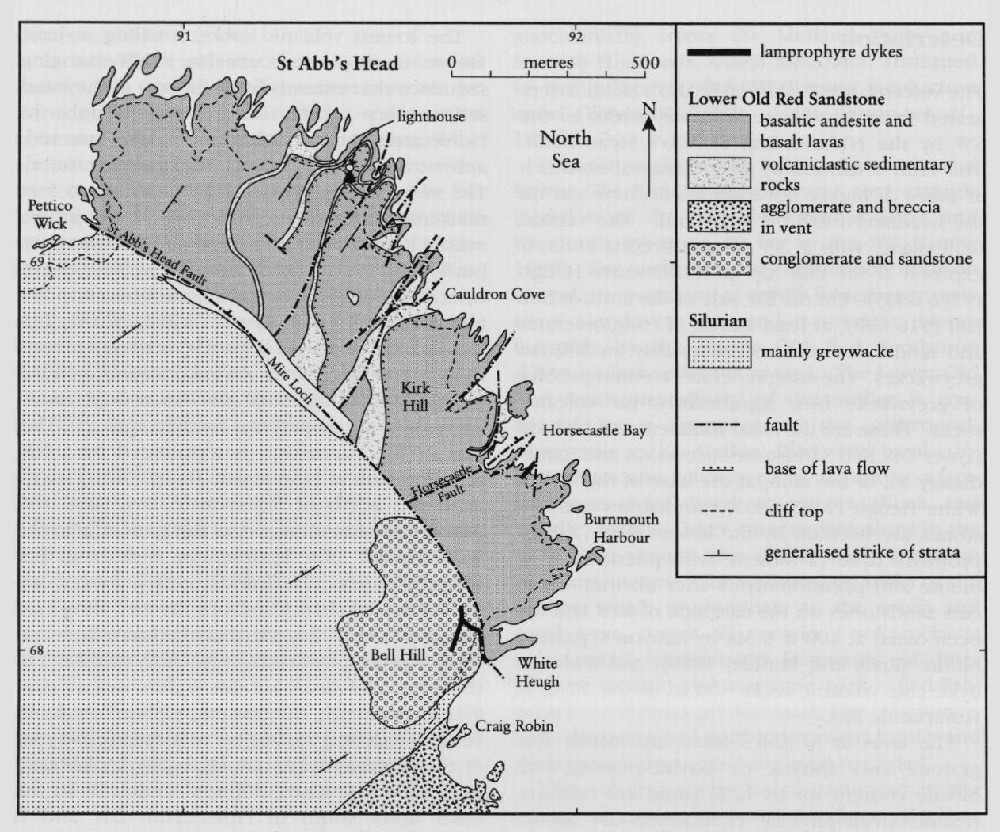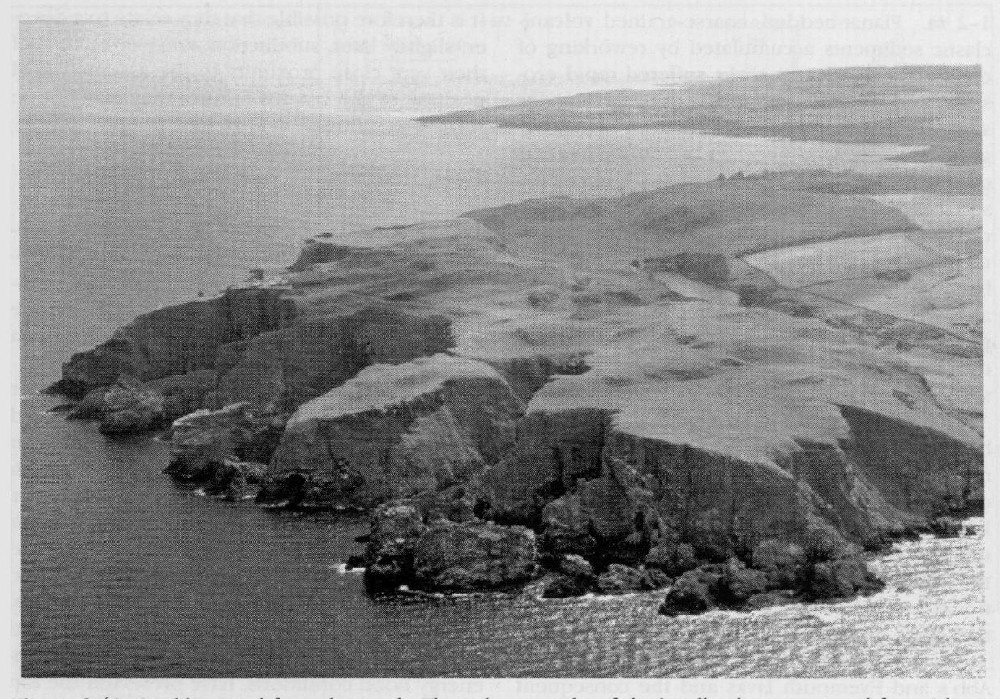Pettico Wick to St Abb's Harbour
D. Stephenson
Introduction
The volcanic rocks around St Abb's and Eyemouth are the best-exposed remnants of late Caledonian extrusive igneous rocks south of the Southern Upland Fault. The only other lava field, in the Cheviot some 25 km to the south, is more extensive but is less well exposed. A number of subvolcanic vents of comparable age and petrological affinity in Kirkcudbrightshire (see the Shoulder O'Craig GCR site report) provide evidence of volcanic activity farther to the SW. Although these volcanic rocks have overall calc-alkaline petrological characteristics, comparable with many modern orogenic suites, they do not conform to the systematic regional variations in geochemistry across the Midland Valley and Scottish Highlands, which have been attributed to the influence of a NW-dipping subduction zone (Thirlwall, 1981a, 1982; Fitton et al., 1982).
Volcanic rocks occur within an outlier of Lower Old Red Sandstone rocks that extends inland from the coast between St Abb's and Eyemouth for some 10 km to the SW (Greig, 1988). The outlier rests unconformably upon an irregular topography of tightly folded greywack-es of Llandovery age, and is overlain unconformably by the Upper Old Red Sandstone (Devono-Carboniferous in age). The Lower Old Red Sandstone affinity of the outlier is confirmed by a fragment of the arthropod, Pterygotus sp. (A. Geikie, 1863) and basal conglomerates and volcanic rocks are cut by a lamprophyre dyke dated at 400 Ma (Rock and Rundle, 1986). Other igneous intrusions in the immediate vicinity give similar Early Devonian radiometric ages. The sedimentary rocks of the outlier, which predominate to the south and south-west, almost all contain a volcaniclastic component, comprising fragments of fine-grained basaltic and andesitic rock. Reddish-brown sandstones predominate, but conglomerates, siltstones and mudstones occur locally and pedogenic cornstones have been recorded.
The volcanic rocks are concentrated in the coastal area, where two major and several minor vents have been recognized, and along the NW edge of the outlier. The GCR site comprises a 600 m-thick sequence of lavas and interbedded volcaniclastic sedimentary rocks that forms St Abb's Head, and a subvolcanic vent to the south, centred upon St Abb's village
Description
The volcanic succession of St Abb's Head is separated from Silurian sedimentary rocks to the SW by the NW-trending St Abb's Head Fault. This fault is marked by a low-lying valley, which at times of higher sea level would have cut off the headland from the mainland. The vertical fault plane, with a 2.5 m-wide breccia zone, is exposed at the cliff top at Hardencarrs Heugh
The lavas at St Abb's Head are mostly fine grained and aphyric or olivine-phyric, with olivine content up to 12%; some are orthopyroxene-olivine-phyric. Phenocrysts are always pseudomorphed by secondary minerals. The groundmass generally consists of flow-aligned laths of plagioclase (labradorite to andesine when fresh), iron oxides and pseudomorphs after clinopyroxene. In some rocks biotite occurs as 'spongy' plates in the groundmass or associated with felsic segregations. Compositions are probably mostly in the range basalt to basaltic andesite, but in general the rocks are so altered hydrothermally that petrographical distinction is unreliable; rocks with over 5% olivine phenocrysts are generally considered to be basalts (Greig, 1988). Major element analyses are also unreliable, particularly because quartz is common in amygdales, as veins and as secondary silicification, exaggerating the silica content; all of the samples analysed by Thirlwall (1979) have silica in the range 54–57%, within the field of basaltic andesite. Feldspar-phyric lavas occur only on the east side of Kirk Hill, at the very top of the succession, but elsewhere in the outlier feldspar-phyric andesites are common and a single flow of dacite occurs near Eyemouth.
The lowest volcanic rocks, totalling at least 100 m in thickness, occur in a NW-younging sequence that extends from the top of the basal sedimentary rocks at White Heugh to Horsecastle Bay. Most of these lavas are red, aphyric, very finely vesicular and autobrecciated.
The more massive parts of flows are up to 5 m thick and commonly exhibit good flow-jointing, mostly tabular and parallel to the flow margins but locally curved to bulbous suggestive of viscous flow. Most of the autobrecciation appears to have occurred in situ in blocky flows, but locally large tabular blocks of lava, tens of metres long, occur in poorly sorted, crudely bedded elastic units suggestive of down-slope mass movement accompanying the brecciation. This part of the succession is terminated by a NE-trending fault at Horsecastle Bay.
To the north of Horsecastle Bay, lavas and interflow sedimentary rocks dip generally to the SE at 30–40°. The sedimentary rocks, together with rubbly vesicular flow margins, are more easily weathered than the more massive flow centres and form hollows in a marked dip slope and scarp topography that is particularly well seen to the west and south of the lighthouse
Shore and cliff exposures in the southern part of the GCR site are of breccia and agglomerate, consisting largely of unbedded, poorly sorted, very large blocks of igneous and volcaniclastic rock up to 2 m in diameter, many of which are moderately well rounded. Some large coherent masses of both lava and bedded volcaniclastic sedimentary rock occur, but their distribution and orientation is chaotic. In places a crude 'bedding' or size grading can be discerned, but this too has no obvious pattern. Many of the lava fragments are similar to those of the St Abb's Head succession, but there are also many that are feldspar-phyric. Some porphyritic andesites were considered by Greig (1988) to be intrusive into the fragmental rocks. At the NW margin of the agglomerates is a 100 m-wide zone of highly brecciated rocks with a marked, coarsely careous weathering that trends NE–SW through Craig Robin. To the north, this zone adjoins sheared Silurian greywackes and the marginal breccia contains blocks of both lava and sedimentary rock, including much yellowish weathering siltstone, in a finely comminuted matrix. Both the marginal breccia and the country rock are cut by abundant thin anastomosing veins of silica, carbonate and haematite. Although not exposed, the contact must be steep or vertical.
Interpretation
Outcrops of coarse breccia and agglomerate extend for almost 1 km on both sides of St Abb's village. Their unbedded, ill-sorted, chaotic nature, the rounding of the fragments and the steep, brecciated and veined margin are all indicative of a subvolcanic vent, as was first suggested by James Geikie (1887). A vent of similar size and nature occurs at Callercove Point between St Abb's and Eyemouth, and a cluster of small vents of a more basaltic nature around Hollow Craig, 5 km NW of St Abb's may also be related. These vents form a NW–SE trend, parallel to the coast, and it is tempting to suggest the presence of a volcanotectonic lineament which controlled the site of a group of small volcanoes and subsequently resulted in faulting on a similar trend. Detailed relationships between the vents and the volcanic sequences are not exposed. There is a general correspondence of rock types, but the St Abb's vent contains blocks of feldspar-phyric lava which are typical of the Eyemouth sequence rather than that now preserved at St Abb's Head.
The basal lavas, between White Heugh and Horsecastle Bay, are viscous autobrecciated flows that probably built up a moderate feature with sufficiently steep slopes to generate syn-eruptive mass-flow breccias on its flanks. Bedded volcaniclastic sediments were not deposited at this stage. Later eruptions, represented by the sequence between Pettico Wick and Kirk Hill, produced more massive, and possibly slightly more basic, blocky lavas up to 50 m thick. Between each eruption, weathering and oxidation of the flow tops occurred to a depth of 1–2 m. Planar-bedded, coarse-grained volcaniclastic sediments accumulated by reworking of debris as the volcanic rocks suffered rapid erosion. Reverse grading in many of these deposits suggests that they accumulated from high-energy flood deposits rather than by settling in areas of still water, and in several places blocky flow surfaces have been perfectly preserved by the rapid burial. If pyroclastic activity did accompany the eruptions of lava, the products must have been destroyed by erosion in a very short time, although obvious reworked pyroclasts, such as pumiceous or scoriaceous fragments are rare in the volcaniclastic sedimentary rocks now preserved.
The St Abb's and Eyemouth volcanoes probably had a limited lateral extent and the volcanic rocks give way to sequences entirely composed of volcaniclastic sedimentary rocks within a few kilometres to the south. Hence they were unlikely to have been connected directly with the Cheviot volcano and there is little compositional overlap between the two areas, although they were broadly contemporaneous.
The general high degree of alteration of the St Abb's and Eyemouth lavas and the consequent small number of samples analysed precludes any detailed geochemical discussion. Thirlwall (1979) describes them as calc-alkaline with relatively high Ni and Cr contents, implying a mantle component to the parental magma. However, they differ in detail from other Siluro-Devonian volcanic sequences and, although two groups of samples are identified, each with very distinct variation trends of many elements, neither of these can be attributed to simple fractional crystallization or progressive partial melting models. Like the Cheviot lavas, they do not fit into the spatial variation pattern of key elements such as Sr, Ba, P, K/Th and La/Y, which led Thirlwall (1981a, 1982) to suggest that the compositions of other Siluro-Devonian lavas relate to their position relative to a subducted slab of oceanic lithosphere. As with the major intrusions and dyke-swarms in the Southern Uplands Terrane (Rock et al., 1986b), the chemistry of the lavas suggests magma generation at depths far greater than would have been possible, given their position relative to the proposed subduction zone. Both St Abb's and Cheviot are slightly later in age (400+ to 390 Ma) than the more northern lava sequences (424–410 Ma), the closure of the Iapetus Ocean, and the implied period of late-tectonic subduction (Thirlwall, 1988). It is therefore possible that they relate to a deeper, slightly later, subduction zone; or in view of their very close proximity to the assumed final position of the Iapetus Suture, they may not be related to subduction at all (see Chapter 1).
Conclusions
This GCR site is of national importance as a representative of the most south-easterly Siluro-Devonian volcanic centres. The lavas were probably erupted some time after closure of the Iapetus Ocean and provide evidence of magma generation in the region of the suture.
The high sea cliffs of St Abb's Head, together with abundant craggy exposures and a marked dip slope and scarp topography inland, exhibit magnificent three-dimensional sections through a 600 m-thick lava sequence associated with a small calc-alkaline volcano. Block flows of basalt and basaltic andesite exhibit a variety of internal features including flow-jointing, vesiculation, auto-injection, autobrecciation and mass-flow brecciation. Volcaniclastic sediments, derived from the local lavas and deposited under high-energy flood conditions, have preserved the top surfaces of several flows. Very coarse agglomerates of a related subvolcanic vent are well exposed on the foreshore NW of St Abb's Harbour and the steep, brecciated and hydrothermally veined margin of the vent can be seen particularly well.


